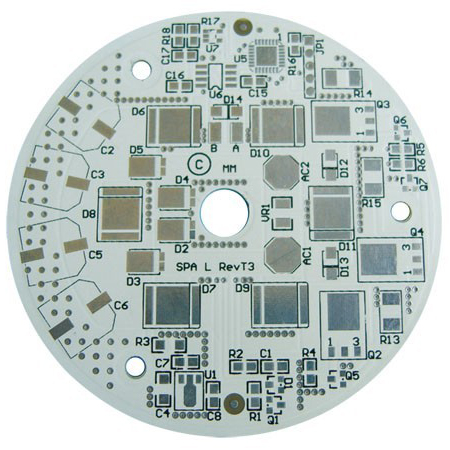
Diya Electronics has been producing Aluminum Printed Circuit Boards (also called Metal base PCBs). Although, originally envisioned for use in the power-supply industry these substrates are now most widely used in High Brightness LED products. There are many names for these products; Aluminum clad, Aluminum base, Metal clad (MCPCB), Insulated Metal Substrate (IMS or IMPCB), thermally conductive PCBs, etc. but they all mean the same thing.
A thin layer of thermally conductive but electrically insulating dielectric is laminated between a metal base and a copper foil. The copper foil is etched into the desired circuit pattern and the metal base draws heat away from this circuit through the thin dielectric.
Aluminum PCB is a unique metal-based copper clad laminate; it has good thermal conductivity, electrical insulation and machining performance. Aluminum PCB market mostly Fuchs Wright aluminum substrate. Common in the LED lighting products.
Aluminum PCB is one of metal-based pcb, including copper foil, thermal insulating layer and metal substrate, its structure divide into three layers:
The heat dissipation afforded by this construction is dramatically superior to standard FR-4 constructions. The dielectrics used are typically 5 to 10 times as thermally conductive as conventional epoxy-glass and a tenth of the thickness resulting in thermal transfer exponentially more efficient than a conventional rigid PCB.
Although Power Converters and LEDs are the largest users of these products, Automotive and RF companies are also looking to take advantage of the benefits of these constructions. A single layer construction is the simplest, most thermally conductive and most cost effective construction. Designs with higher component counts may not have room for all the required routing on a single layer. In this case a two layer design is required. A thin sheet of dielectric, typically around .006” thick, is drilled, plated and etched much like a standard double sided printed circuit board. The sheet is then laminated using thermally conductive bonding material to the metal base. This extra routing layer results in components farther away from the heat-sink and reduced heat transfer so this construction is recommended only when necessary.
Light Assemblies
Automotive Dashboards
Power Converters
Power Supplies
Power Transmission Systems
Ignition Systems
Power Distribution Products
Surgical Lighting
Scanning Technology
Camping Gear
Aircraft Landing Lights
Aircraft Running Lights
Spot Lights
Flash Lights
Traffic Control Lights
Traffic Control Lights
Landscape Loghting
Interior Lights
Automotive Headlights
Automotive Tail Lights
